Cucumber variety "Zhuravlenok" from Crimean breeders for growing in warm climates
The modern market is replete with seeds of various varieties and hybrids cucumbers. In pursuit of new advertised varieties, which often do not meet expectations, gardeners forget about the crops tested over the years. Cucumber Crane is just one of them. More than 20 years have passed since its inception, and those who value quality and reliability grow it steadily.
The hybrid is valuable for high productivity, unpretentious care and excellent fruit taste. Today we will talk about the rules for growing crops in a greenhouse and a vegetable garden, shaping bushes, the difficulties of growing and methods of controlling pests and downy mildew.
The content of the article
Description of the hybrid Crane
The f1 crane is a mid-early hybrid of domestic selection. The breeding was carried out by biologists of the Krasnodar branch of the Crimean experimental selection station. In 1996, the hybrid was approved for cultivation in the Volgo-Vyatka, Central Black Earth, North Caucasus, Nizhnevolzhsky, Ural, West Siberian, East Siberian regions. The culture is grown in indoor and outdoor fields.
The main stem reaches 1.9 m in length and produces 3-5 shoots. Climbing bushes, medium leafy. 4-5 fruits are formed in one node.
In the photo - a hybrid of Cranes.
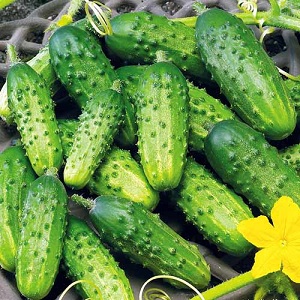
The table contains the characteristics of the culture.
| Indicators | Characteristic |
| Ripening period | 41-45 days |
| Pollination type | Bee-pollinated hybrid |
| Weight | 80-110 g |
| Length | 11-12 cm |
| The form | Elliptical |
| Coloration | Green, with white blurred stripes |
| Leaves | Medium size, green color |
| Pulp | Dense, crispy, no voids |
| Taste | Sweetish |
| Skin | Thin, with large tubercles and black sharp spines |
| Appointment | Universal |
| Yield | 7-10 kg / m² |
| Sustainability | To bacteriosis, common cucumber mosaic and powdery mildew |
| Transportability | High |
Chemical composition, calorie content and benefits
The calorie content of cucumbers is only 14 kcal per 100 g.
Chemical composition of the product:
- vitamins A, B1, B2, B4, B5, B6, B9, C, E, H, K, PP and beta-carotene;
- minerals: potassium, calcium, silicon, magnesium, sodium, phosphorus, iron, iodine, copper, selenium, fluorine, zinc.
Regular consumption of cucumbers has a positive effect on the body:
- normalizes water-salt balance;
- accelerates metabolism;
- dilates blood vessels;
- normalizes blood pressure;
- breaks down cholesterol plaques;
- dissolves stones and sand in the kidneys;
- normalizes the work of the pancreas;
- improves blood counts.
Agrotechnics of cucumbers
Hybrid Cranes are grown by seedling method and through direct sowing into the ground. The second method is preferable for the southern regions.
The crop requires moderate watering, application of organic and mineral fertilizers, shrub shaping and assistance with pollination when grown in a greenhouse.
Seed planting
Direct sowing of seeds in the ground begins no earlier than the end of May in the southern regions and early June in the regions of the middle zone. When choosing a location, preference is given to areas on the south side, without drafts. Soil temperature should be at least +16 ° С.
The soil for planting cucumbers is prepared in the fall - they dig it up and bring in a bucket of humus per 1 m². In the spring, the soil is re-loosened and fertilized with chicken droppings (10 l / 1 m²).
Experienced farmers recommend sowing green manure in early spring. Most often, rye, oats, clover, lupine, beans, peas are sown.What does it do? Plants serve as an excellent nutrient for the soil, improve its structure, saturate it with nitrogen, and act as mulch.
After the plants stretch 10-15 cm, holes are made in the beds, right in the green manure, and cucumber seeds are sown in them to a depth of 3 cm with an interval of 20 cm. Sprinkle with a layer of earth on top and cover with halves of plastic bottles. After germination, the shelter is removed.
Siderata reliably protect young shoots from wind and sun. As soon as the seedlings get stronger, the plants are cut.
In practice, the second method is also used, in which green manure is mown before sowing seeds. Gardeners explain this by the fact that they inhibit the growth of cucumbers.
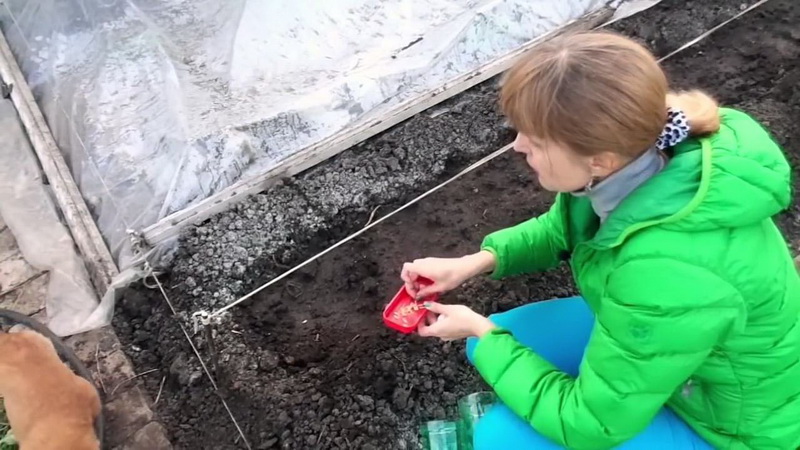
Seedling planting
Sowing seeds for seedlings is carried out in the last days of April. The soil is prepared independently from two parts of peat and humus and one part of sawdust. Add 25 g of superphosphate and a glass of ash to a bucket of soil mixture. Mix thoroughly and fill with a strong solution of potassium permanganate for disinfection.
Wet soil is laid out in peat containers with a volume of at least 0.5 liters. In them, the seedlings are subsequently planted in the ground.
The depth of planting seeds is 2-2.5 cm. Polyethylene is stretched from above and waiting for shoots. Sprouts will appear in 3-5 days at a temperature of +25 ° C.
After the seeds hatch, the film is removed, and the seedlings are taken out on a windowsill with sufficient lighting. Seedlings are watered abundantly - once every 7-10 days.
For feeding, use ready-made fertilizers: "Bud", "Ideal", "Breadwinner", "Barrier".
It is recommended to feed cucumber seedlings with milk with iodine to increase the protective forces. To do this, take 1 liter of low-fat milk and 10 drops of iodine in a bucket of water. The solution is used to spray seedlings.
The transfer of seedlings to the greenhouse begins in the last decade of May, to the garden - in early June.
Planting scheme - 50 × 60 cm, 3 bushes in closed ground, 4 bushes in the open.
The wells are formed at a depth of 20 cm and poured with boiling water or a hot solution of potassium permanganate. After the soil has cooled, seedlings are planted. The soil is covered with mulch - peat, sawdust, straw or agrofibre - to prevent weed growth and moisture retention.
Care
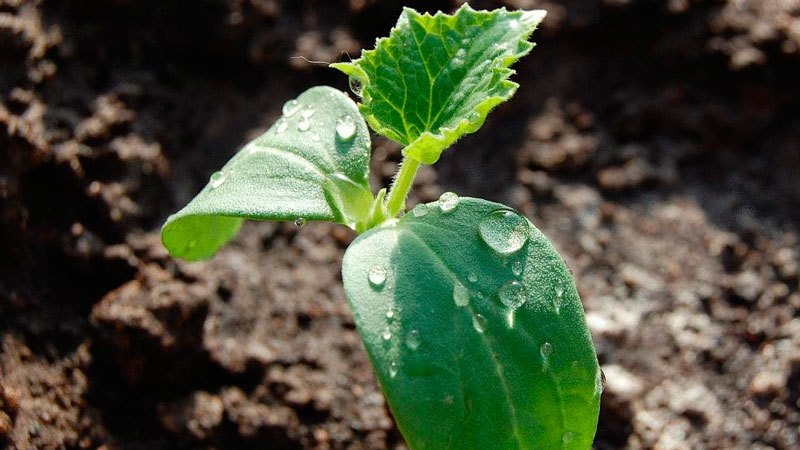
Cucumbers grow best in light humus soil with an acidity of 6.5-7.2. The optimum temperature for development and growth is + 22 ... + 26 °C. At an air temperature below +14 ° C and above +42 ° C, the vegetation of plants is suspended.
For irrigation, use warm rain or settled water. The bushes are watered strictly at the root in the evening. The drip irrigation system helps to facilitate the care of cucumbers and keep the moisture level in the soil under control.
The loosening procedure in the greenhouse is carried out carefully, taking into account the surface location of the roots. The root system of indoor cucumbers is weaker than that of garden plants, and often comes to the surface. Instead of loosening, some gardeners pour soil into the aisles after watering.
The Crane hybrid is fed up to five times per season, alternating organic matter with mineral compositions. The frequency of fertilization is once every 10-15 days. The soil is moistened before this.
Top dressing options:
- the first - after planting: solution of chicken droppings 1:15;
- the second - during the flowering period: 50 g of superphosphate, 25 g of urea / 10 l of water;
- the third - during fruiting: infusion of tops or nettle, diluted with water 1: 5;
- the fourth - during the harvest period: solution of chicken droppings 1:15;
- fifth - to prolong fruiting: 30 g of potassium nitrate / 10 l.
For foliar treatments, a mixture of 10 g of urea and 6 g of potassium sulfate per 10 l of water is prepared. Spraying is carried out on a cloudy, windless day.
Features of cultivation and possible difficulties
Sprawling bushes of the Crane are formed according to the multi-stem technique and tied to a trellis. This provides additional ventilation and increases yields.
Forming rules for bee-pollinated hybrids: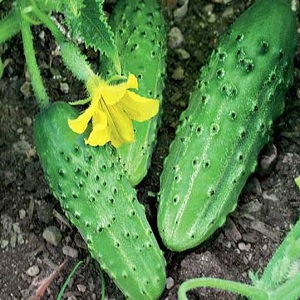
- After the appearance of 4-5 leaves, the bush is tied to a trellis.
- Lateral shoots are left until the first ovary appears, and then they are tied to neighboring trellises or pulled to the main stem. To avoid injury to the lashes, adhere to an angle of 60 ° between the lateral and central shoot.
- Lateral shoots are twisted around the main stem, and then they are fixed with antennae.
- The entanglement procedure is periodically repeated, excess antennae and shoots are removed.
- When the main stem becomes higher than the trellis, it is wound around it several times or thrown over and pinched the crown.
Council. At the end of the growing season, remove weak shoots and existing ovaries in the axils. Then the plant will direct its forces to the growth of the remaining fruits.
When growing a Crane hybrid in a greenhouse, it may be difficult to pollinate. To attract bees, the vents and doors are kept constantly open, or the pollen is transferred by hand.
Cucumbers are monoecious plants, female and male flowers are on the same bush. To collect pollen from a male flower, use a paintbrush or a cotton swab, or simply tear off the peduncle and apply it to the female flower.
Reference. When the air temperature in the greenhouse is above +30 ° C, the pollen becomes sterile. Therefore, the main task of the farmer is to maintain the optimal temperature regime.
Diseases and pests
Hybrid Crane is susceptible to downy mildew, or peronosporosis. Fungal disease is a lot of trouble and, without timely treatment, can destroy the planting of cucumbers.
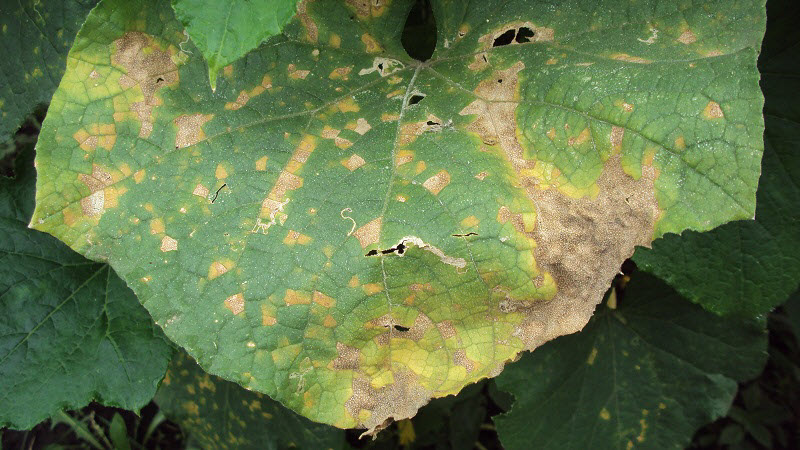
Signs:
- small brown or yellow spots on greenery;
- purple bloom with a gray tint on the back;
- yellow and dry leaves in the last stage.
The reasons:
- high humidity and air temperature below +9 ° С;
- uncontrolled watering with cold water;
- rainy summer;
- alkaline soil.
Prevention:
- soil disinfection with copper sulfate (50 g / 10 l / 1 m²) or "Fitosporin";
- harvesting plant residues at the end of the season;
- removal of infected bushes;
- constant loosening and weeding of beds;
- crop rotation.
Treatment:
- chemicals: 0.5% solution of Bordeaux liquid, "HOM";
- folk remedies.
Folk remedies recipes:
- 1 liter of kefir or milk whey and 10 drops of iodine. Bring the solution to a volume of 10 liters and spray the cucumbers once a week.
- 400 g of ash, pour 1 liter of boiling water and leave for four hours. Strain and add water to a volume of 10 liters. Use on bushes once a week.
- Prepare a pink potassium permanganate solution and process the plants twice a month.
- Dissolve 25 g of soda and 5 g of tar soap in 5 liters of water. Process the bushes twice every 3-4 days. Repeat after a week.
Proven efficacy against whitefly, aphids, spider mite thrips are possessed by the preparations Fitoverm, Aktara, Fury, Inta-Vir, Calypso, Aktara, Aktellik.
To obtain environmentally friendly products, folk remedies are used:
- Pour 30 g of finely chopped hot peppers with 10 liters of water, leave for 24 hours;
- Pass 0.5 kg of dandelion leaves and roots through a meat grinder and pour 5 liters of water, after 3 hours add 2 tbsp. l. mustard powder;
- 100 g of onion husks pour 3 liters of boiling water, leave for 24 hours, mix in 20 g of soap shavings.
Spraying frequency is once every 10-14 days.
Harvesting and application of the crop
Harvesting begins in about 45-48 days. The fruits have excellent taste, do not taste bitter, and are suitable for fresh consumption and preservation.
For winter harvesting, cucumbers are used, collected at the stage of milk ripeness.
Harvesting is carried out regularly, in the morning hours, as the fruits are prone to overgrowth and loss of taste.
Cucumbers tolerate transportation well. Stored for about three months in a cool place.
Advantages and disadvantages
Advantages: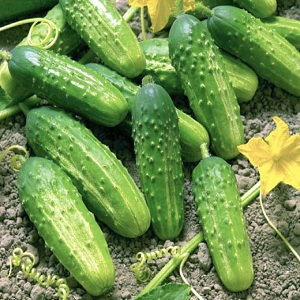
- excellent taste;
- early maturity;
- immunity to major diseases;
- high productivity;
- unpretentious care;
- resistance to changes in average daily temperature;
- keeping quality;
- high level of transportation;
- affordable cost of seeds.
Disadvantages - susceptibility peronosporosis and the need to form bushes.
Reviews
The Crane hybrid appeared more than 20 years ago and managed to win the love of large farmers and summer residents due to the ease of planting and care, excellent taste and high productivity.
Valery, Liski: «I plant cucumbers Cranes all the time in the garden at the dacha. There have never been any problems. The culture is rarely sick, not demanding on the composition of the soil. I installed drip irrigation on the site and covered it with agrofiber. The fruits are very juicy and crispy, the skin is thin, not hard. "
Irina, Vladimir: “I have known the hybrid for a long time, I grow it in a greenhouse and in a vegetable garden, if there is room for planting. Since the cucumber is pollinated by bees, you have to transfer the pollen by hand. This applies to bushes in the greenhouse. In the open field, these problems are not. I like the culture for its unpretentiousness, the ability to harvest until late autumn. The cucumbers are juicy, dense, ideal for pickling, despite the thin skin. "
Conclusion
The bee-pollinated hybrid Zhuravlenok is liked by gardeners for its excellent taste and unpretentious care. Some people note that such cucumbers are significantly superior to parthenocarpic ones in taste and aroma. Growing difficulties arise when planting crops in a greenhouse.
Bees are reluctant to fly indoors, so you have to wield brushes to transfer pollen from a male flower to a female one. Otherwise, caring for the plant is not particularly difficult. It is important to organize moderate watering, loosen and weed in time, form bushes and tie them to a trellis, add organic matter and minerals.